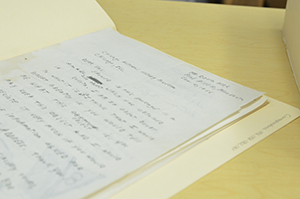The notes, personal papers and journals of Minnesota archaeologist Douglas Birk are now open to researchers thanks to a new finding aid.
A finding aid is a primary reference tool researchers use to explore and get access to archival collections. It provides context a researcher needs to interpret the collection and describes the layout and arrangement of the collection. The Birk Collection finding aid was developed by Project Archivist Barrett Codieck, with the assistance University Archivist Tom Steman and graduate students Jackson Rohde, Oskar Lizotte, and Kylee Glenn. The project was financed with funds provided by the State of Minnesota from the Arts and Cultural Heritage Fund through the Minnesota Historical Society.
The Douglas A. Birk Collection is housed in the Department of Anthropology at St. Cloud State University thanks to a donation from Birk’s estate in 2018. Birk was a prolific Minnesota archaeologist who was an expert on fur trade history and archaeology, the early European exploration of the upper Mississippi River valley, 19th century missions, the logging industry, and the early railroad system in Minnesota.
Birk’s collection of books, papers, maps and artifacts is one of the most comprehensive resources that looks at the fur-trade era anywhere in North America. It is a tremendous resource for researchers interested in the era and Minnesota and will provide source material and research ideas for student theses and research, said Dr. Rob Mann, St. Cloud State professor of Anthropology. The collection is now housed in Stewart Hall and is protected in temperature and moisture controlled cabinets.
His personal papers alone, spanning his 50 year career in archaeology, filled six filing cabinets and multiple boxes.
“We took everything out of the filing cabinets and stacked the boxes by drawer and filing cabinet number. That was the basis of the finding aid,” Mann said. “Then we inventoried it, sorted it in to groupings that made sense so that other researchers could make sense of it to locate the materials they wanted to find.”
Codieck began working on the finding aid in July and completed the project by the end of November before finishing up his work, which included developing a protocol for access to the materials, which include sensitive information about the location of important historical sites.
Researchers have already begun using the finding aid and Birk’s library to inform their own research.
The library consists of more than 2,000 books and it meets or exceeds most institutional libraries for its subject matter covering the history of Minnesota in the fur trade and logging industry as well as Native American history and missions in the state, Mann said.
The collection is unique because, in addition to books, it contains several hundred manuscript reports of archeological and historical sites
“I doubt that in the United States there is another collection of these kind of reports,” he said. “They focus in on particular subjects and time periods, but for someone interested in the fur trade, I doubt there is anywhere in north America you could find this set of comprehensive reports on the subject.”
In addition to Birk’s papers, the collection consists of an extensive research library consisting of more than 2,000 books, journals and archaeological site reports. The collection also includes archaeological materials from site 21MO20, an 18th century fur trade post in Morrison County listed on the National Register of Historic Places site, on permanent loan from the Morrison County Historical Society.
The Department of Anthropology is in the process of seeking additional grants to fund inventorying, cataloging and protecting Birk’s artifacts, maps and photo slides that also belong to the collection.

